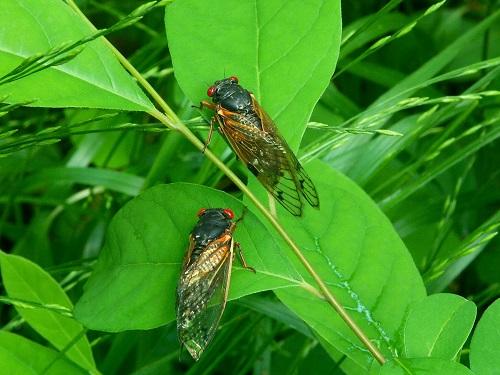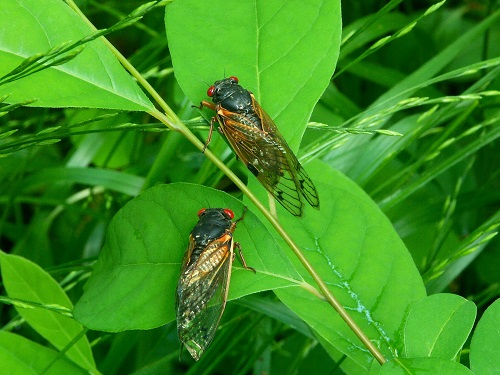

That’s right – the big, noisy bugs are getting ready to emerge by the trillions and while they don’t sting or bite, they do stand to disrupt outdoor sporting events – particularly those on grass fields. And in their last appearance (2004), they impacted everything from municipal tennis to the PGA TOUR.
For those who require an introduction (lucky you if you haven’t been acquainted with these critters previously), cicadas look a bit like a giant fly, with bodies about an inch long (and wing spans of about three inches). They emerge from the ground in nymph form (usually around mid-May), bearing a passing resemblance to a tiny crayfish.
The nymphs, brown in color, then climb trees, bushes, light posts – whatever they can find – and hatch out into their full red and black glory. They spend the next few weeks flying around (clumsily) and searching for mates (generally successfully) while singing (loudly). Their song has been compared to thousands of rattlesnakes rattling and hissing at once. (Some cicada calls reach 160 decibels (as loud as a jackhammer) and can be heard up to 1 mile (1.5 kilometer) away, according to National Geographic. After they mate, they lay eggs and die. Everywhere.
Well, that's deeply gross but at least they’re not murder hornets. (And although they are sometimes called locusts due to their plaguelike numbers, the term, locust, technically applies to grasshoppers rather than cicadas). Oh, and in case you’re one of those people who likes to help scientists trace emergences, there’s an app for that.
BBC has an excellent video here showing the cicada emergence and it really gives a good sense of why it is being nicknamed the “swarmageddon.”
According to USA TODAY, One of the largest broods of periodical cicadas in the nation, Brood X (and entomologists want you to know that’s 10 in Roman numerals, not X, like your crazy ex-whatever) will emerge this spring mainly in 15 states: Delaware, Georgia, Illinois, Indiana, Kentucky, Maryland, Michigan, North Carolina, New Jersey, New York, Ohio, Pennsylvania, Tennessee, Virginia, West Virginia and Washington, D.C. – with smatterings in other states (Wisconsin, South Carolina and more) as well. (Within states, the concentrations tend to vary from area to area, since cicadas like certain types of soil but not others; for example, they are rarely found in an affected state’s tidal area since they find sandy soil to be uninhabitable).
Fun fact: Various broods of cicadas come out at different times worldwide; in India, one emergence is known as the World Cup Cicada because they come out in June and July quadrennially, at the same time that event is played. Yes, really. And no, they won't reschedule their emergence to November/December for 2022. FIFA doesn't have that much influence.
The amount of time this year’s Brood X cicadas will be around depends upon the state and the local weather, but is generally between two and four weeks – and that May/June time window hits just as outdoor youth sports are really gaining traction. And while many people are unbothered by bugs (even big ones) and many will recognize cicadas as harmless, expect plenty of spectators and athletes, particularly those from out of town, to be unnerved by the sight (and deafening sounds) of the bugs. In fact, it might even be an opportunity for event owners to provide a link to an educational site with FAQs about cicadas.
Of course, in areas where cicadas will emerge, tens of thousands to over a million insects can reside in a relatively small area of land, meaning affected states stand to see a LOT of cicada action, often to the point where grass will appear to undulate as the bugs crawl across it. The real bottom line here, particularly for sports events, is that cicadas will probably be pretty noticeable. And unfortunately, theyhave a habit of dive-bombing spectators and athletes (see the previous note about their clumsiness). That can make for some real freak-outs, particularly among those who have never seen cicadas before, or who tend to be squeamish. In 2004, for example, a kickball game in Virginia was disrupted as players frantically dodged cicadas.
Jerad Minnick, the fields consultant for the Maryland Soccerplex, says the infestation is likely to be something venue owners and events will have to deal with, depending upon their location. Older fields are particularly susceptible, he notes.
“I can definitely see it being an issue in places that are surrounded by trees, or places where the soil hasn’t really been disturbed,” he notes. “Newer facilities, where the soil has been moved to create fields, or where there is a lot of development, it probably won’t be as much of an issue.”
The Maryland Soccerplex is a newer complex, plus it has a regimen of natural methods of pest control to keep grubs at bay. Minnick is hopeful the combination will mean fewer cicadas – and less disruption. Still, he notes, it’s ironic that the industry will have to cope with cicadas this year.
“You feel like this should have happened in 2020 when everyone was inside, and nothing was happening. Right now, people just want to play so badly and every field, every facility needs revenue.”
It’s also unfortunate, he points out, that the cicadas will be out in force over the Memorial Day weekend, “one of the peak times for tournaments.”
"Will cicadas disrupt sports here?" asked Terry Hasseltine, CSEE, CTA, Executive Director of Maryland Sports."No more than COVID. "Seriously, everyone is so thirsty for sports to come back that they'll tolerate the cicadas, even though they're nasty. I mean, what else? 2020 and 2021 have been the years for curveballs and this is just another curveball."
"We are anticipating the cicadas and have discussed with our managers," says Lori McMahan Moore, who manages a number of venues within the SFA|SFM|SFD network. "We are moving forward with all events as planned and will work with our event organizers, should any situations arise."
Venue operators and managers should also keep their maintenance staff in the loop. The Washington Post notes that Dan Mozgai, who owns and operates CicadaMania.com, says cicadas are attracted to lawn mowers, weed whackers and similar machinery because of the sound they make. Essentially, the machines sound like a chorus of cicadas ready to mate. Morzgai provided the story of a Tennessee man who was running a mower, and who reported that 50 to 60 cicadas landed on him while he was working, swarming around him and his mower for more than an hour and alighting on his arms, legs, chest, back, face, hands and mower.
In 2004, the last year we saw a big emergence, the Memorial (one of the PGA TOUR’s most popular events, played annually at Muirfield Village Golf Club in Dublin, Ohio) was seriously impacted, noted the New York Times. In fact, one of players’ biggest concerns was that the bugs would actually distract them in mid-swing, forcing them to hit a bad shot.
''They could actually play a role in the tournament this week,'' Kenny Perry, then the defending champion, predicted. ''Somebody's shot is probably going to get altered this week or get distracted or something.''
And that actually did come to pass. Jay Haas saw it happen to Vijay Singh in a practice round.
''He let go of the club because one hit him in the face on his downswing,'' Haas said of Singh. ''I guess the people around here deal with it.''
Even Tiger Woods was forced to back off a putt when a cicada flew by.
"I thought we had big bugs in Africa but these things..." Ernie Els told the Associated Press, shaking his head. (AP additionally noted the cicadas were almost loud enough to drown out the Ohio State Marching Band when it performed).
Municipal tennis facilities, particularly those in park settings, got hit in a big way. Jenn Char, an Alexandria, Virginia resident, told the GW Hatchet, the independent student newspaper in Washington, DC, that she’d gone to the local court to hit with some friends. It was game, set and match for the cicadas.
“I heard from friends that they are worse on tennis courts, and I thought that sounded crazy,” Char said. “So I went to the courts to play, and they were everywhere. We had to clear them off the court just so we could play. I hit so many with my tennis racquet. I hit more cicadas than tennis balls.”
Of course, not everyone in outdoor sports is squeamish; the Washington Post compiled an article about cicada-induced freak-outs and one reader noted:
“Back in the summer of 1987, I was at an Orioles game in the upper deck at Memorial Stadium. The cicadas were out in full force that night, flying all around. This guy was pulling them out of the air and eating them, and people were giving him dollar bills for every one he ate. He pocketed quite a few dollars that night.”
Plenty of people have fun with the phenomenon, such as this writer who interviewed a cicada for the website, Golf Course Industry. And anglers can also look forward to the emergence. Scott Loughner, a fly fishing instructor and guide from southwestern Pennsylvania, noted in an adventure blog, “Once the fish start seeing them often enough, they realize that’s a lot of protein right there. And everything eats them, from bass and trout to catfish and carp. Everything that swims.”
Loughner ties his own cicadas for casting but with the bugs readily available, they make good live bait as well.
The actual period cicadas are around tends to be about a month, give or take. Unfortunately, the aftermath is, well, gross, notes the Washington Post. When they die (and they do, en masse), cicadas clog pool filters, gutters and storm drains and litter fields, bleachers and other areas. Unless swept away and moved, their carcasses stay wherever they fall and their dead bodies “stink like rotten cheese and meat, particularly if they get wet and are left to rot.”
Fortunately, this happens only once every 17 years. (Affected states do see annual broods of summer cicadas but they are far less numerous and tend not to be problematic).
Events whose tournaments have hospitality events that are held outdoors (receptions, meet-and-greets, dinners and parties) might want to rethink those locations, according to this 2007 article from the LaCrosse Tribune, which noted the experience of an Illinois catering company that provided ice sculptures. The caterer told the Tribune one horror story had made him swear off outdoor events during the time of the emergence.
"We put our tray down and immediately the cicadas came off the ground and attacked the ice. Literally, it was a moving sculpture, this big black ugly mass of cicadas constantly moving," the caterer noted. "I don't want to talk myself out of work, but that was just too gross.”

